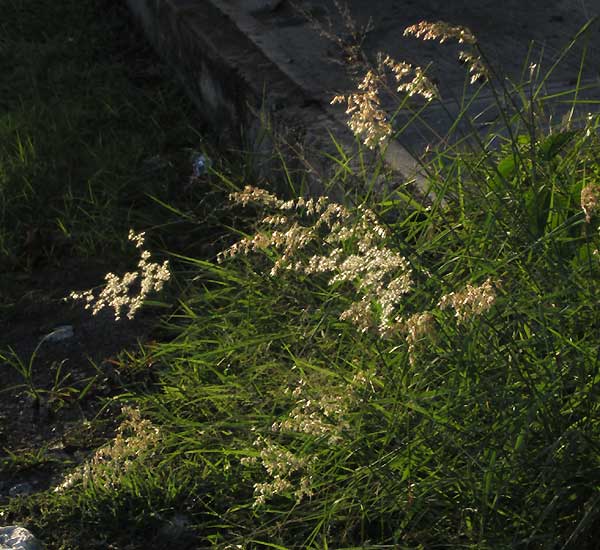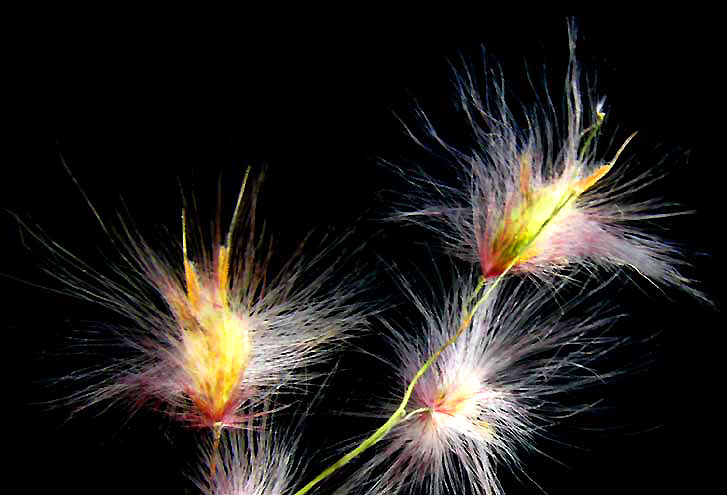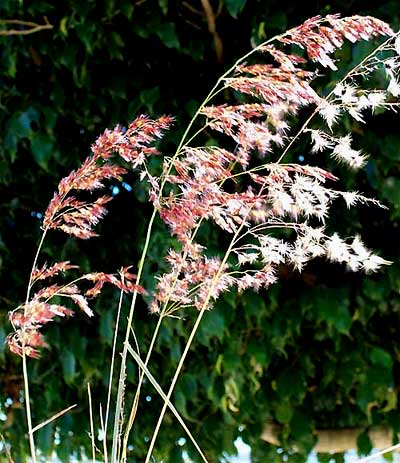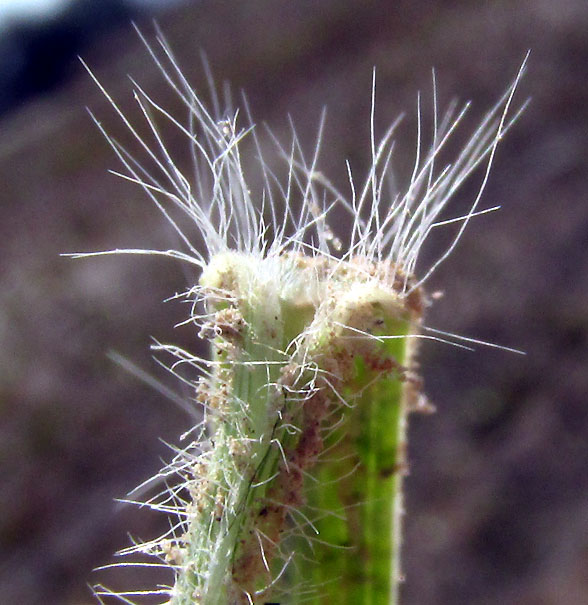Excerpts from Jim Conrad's
Naturalist Newsletter
issued August 30,2019 from Mérida, Yucatán, MÉXICO
RUBY GRASS FROM A CRACK
Wandering Mérida's backstreets as dusk approaches, sunlight slanting in from the west illuminates a population of thriving Ruby Grass, MELINIS REPENS, issuing from a narrow break between a sidewalk and the street's asphalt, shown below:

The plant, despite its bad reputation in some places, deserves special attention, if only because it's so pretty when sunlight hits it just right.

These spikelets are spectacularly hairy, and the glumes are tipped with needle-like awns. But this species is very variable, especially in terms of its hairiness, growth-form, and the length of the internode between the glumes. Hairinesse, spikelet color, and growth-form are of no taxonomic value because they vary so much. Some forms have hairless glumes.
from the January 26, 2007 Newsletter issued from Sierra Gorda Biosphere Reserve, QUERÉTARO, MÉXICO
RUBY GRASS
I retain lots of vivid memories from my first trip through Mexico back in the late 60s. I still remember the esthetic effect created by a certain red-topped grass that nearly always grew atop the archaeological ruins I visited. Atop pyramids nearly always there was a nice breeze and a feeling of being closer to the sun, and nothing captured the feeling of mingling wind and sunlight more than a particular grass whose deep burgundy flowers shook in the wind and seemed to explode with light. You can see that same grass in a picture taken here in Jalpan below:

That's MELINIS REPENS, sometimes called Ruby Grass and Natal Grass. The plant's distinguishing features are that its individual florets are purple and abundantly hairy. It's the hair that catches sunlight, causing windblown inflorescences to be so spectacular when the sun shines from behind them.
I've always associated Ruby Grass with Mexican ruins but now I learn that it's an invasive species from southern Africa found worldwide in the tropics and a bit in the subtopics, especially in dry, disturbed areas. In US southern states usually it's confined to roadsides but in Mexico it's invaded natural grasslands, changing their species composition and structure. When Ruby Grass forms dense stands and catches fire, it burns so hot that native plants are killed, while Ruby Grass itself somehow comes back.
Well, this isn't the first times I've nurtured warm feelings for an acquaintance from way back, only to Google them and find out that they have been up to shady dealings elsewhere.
entry dated May 17, 2022, issued from near Tequisquiapan, elevation about 1,900m (6200 ft), ~N20.57°, ~ W99.89°, Querétaro state, MÉXICO
RUBY GRASS'S LIGULES

A couple of months ago, in the heart of the dry season, the locals, per tradition, set fire to a field along one of my daily walks. It was just one of many such fields, as well as roadsides, pastures, and scrubby areas, which get burned yearly, "to encourage new growth," they like to say. In the long run, it depletes the already abused soil. Robinson & Kirkby's 2002 study called Maize Stubble Management Survey reports that burnt wheat stubble loses 80% of its nitrogen, 44% of its phosphorus, 40% of its potassium, 80% of its sulfur, and similar amounts of other nutrients. Nutrients are converted to gases, or dissolve in rainwater and flow from the field, or as ash are simply blown away.
Nowadays this particular field is still charred black, except for one grass species, which spectacularly during these two months has gone from being cinderized, to issuing new green leaves and going through its reproductive cycle so fast that now it's releasing white-haired, cypsela-type fruits into the wind. Despite these sunlight-gathering inflorescences being pure white, not ruby-red as often is the case, when I looked closely at the flowers it was clear that this really was our old friend Ruby Grass.
Above it's mentioned that Ruby Grass "burns so hot that native plants are killed, while Ruby Grass itself somehow comes back." This field was an example of that, nothing prospering but the invasive, non-native Ruby Grass.
While I had another Ruby Grass in hand, it occurred to me that I'd never documented the species' ligules, which are important if you're trying to identify a grass with only stems and leaves. That's what you see in the above picture